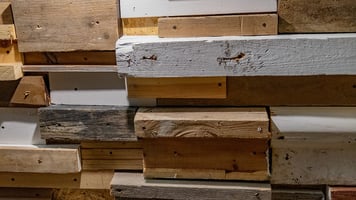The market and demand for reclaimed lumber has grown over the past few decades since it first sprouted into existence. There are many reasons for this, but one of them must specifically do with literal growth. Old trees with strong, rich grain need centuries to finally reach their maximum quality as lumber, and sources available to commercial use are becoming increasingly scarce.The demand for strong older lumber is however no smaller than it's ever been in wood-based construction, despite many good environmental and practical supply reasons for decreasing access to fresh sources.
This is where reclaimed wood comes into the picture. With the increasing scarcity of fresh sources of older lumber, a market began to develop for wood beams, boards, numerous other cuts, and formed wood parts. Formed wood parts could be taken from old wooden structures slated for demolition and then re-cut or sold as-is to others for use in new projects.
This is what reclaimed wood essentially is, and the market for it has grown enormously among contractors. More importantly, demand has also gone up among clients who want a unique aesthetic or architectural design in their homes, without the guilt of contributing to old growth deforestation.
Why Reclaimed Wood?
Its availability has changed over time, but old wood itself remains highly prized because it can keep its beauty and strength indefinitely. There's also the added visual benefit of a beautiful grain produced by centuries of slow growth in this kind of lumber. Reclaimed wood also often has an abundant amount of historical character. There is a deeper, richer coloration and a rustic look in pieces sourced from early or even pre-20th century houses, barns, or other buildings. This appearance can be extremely desirable for rustic touches in bars, restaurants, office buildings or personal homes.
The visual appeal isn't the only benefit of reclaimed lumber products either. Deeply seasoned, dense grained wood, with hundreds of years of growth behind it, is extremely strong, compared to wood from modern industrially farmed tree sources only a few decades old.
You as a contractor can deliver a unique set of structural and visual benefits to your clients if you can offer these sources of aged, reclaimed wood for their interior design and structural needs.
The Benefits of Using Reclaimed Wood Products
Reclaimed lumber pieces are especially useful choices for installation where a visually appealing, but also extremely durable, result is what you or your client wants. This makes reclaimed wood particularly desirable for wood flooring, exposed walls and ceiling beams, tables, or other pieces of furniture. It's also a lovely finishing material for bars, restaurant tables or other large counter tops.
Certain types of old reused wood offer a grain and appearance that's completely unattainable with any newer lumber. It also can't easily be faked with an artificial veneer over cheaper building materials. In these cases, reclaimed wood from very old trees or from tropical lumber sources can be the only possible source of these kinds of surface finishes.
There are also other major benefits to using reclaimed lumber. One of the most obvious among them is the environmental benefit of supplying a demand for recycled lumber products that reduce the strain on still-living older trees in the world.
Using Reclaimed wood also offers a property value enhancing quality, that can't be matched by most other building materials. If you build a home largely decorated and buttressed with reused late 19th century barn beams, that home contains something only very few other houses can also obtain. Buyers appreciate this.
Finding and Installing Reclaimed Lumber
Resellers of reclaimed lumber make it their business to scour old construction sites and planned demolitions for supplies of reclaimed wood products. Some of the places where this historically unique type of lumber is especially available include:
- Old houses that are set for demolition
- Factories
- Old rail yards
- Marine facilities
- Aging ships
- Old cabins
- Old mines
- Retired government facilities
- Country farms
If you decide to work with reclaimed wood for your clients’ specific needs, it becomes particularly important to treat each piece as carefully as possible before and during installation. The purpose of this wood is that it keeps being used while maintaining its visual qualities. This might mean using special tools to install it and avoiding certain conventional methods that work fine for other lumber construction materials.
This applies for nailing your wood beams, siding or other aged, reclaimed wood pieces in. Metal nails can tarnish the appearance of the lumber and ruin its future usability. For reclaimed wood LignoLoc® Wooden Nails, developed by BECK, are a perfect choice! They leave virtually no visible sign of nail installation and don't require any destructive pre-drilling to be pneumatically nailed in.
Lumber pieces locked into place with wooden nails can later be removed and reinstalled again with minimal harm to their appearance, or a need for damaging nail removal. The LignoLoc® Wooden Nails are made from compressed European beech wood, and there for have a very high density and strength. These nails molecularly bind with the surrounding wood using the lignin welding effect.
See the first collated nail made of wood in action for yourself here!
.svg.png)


